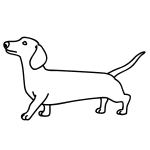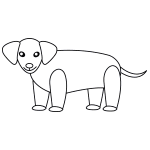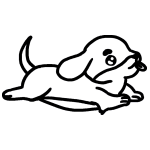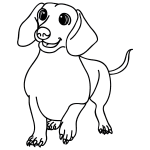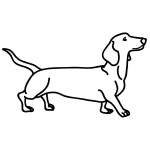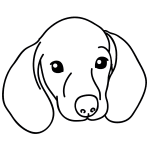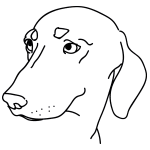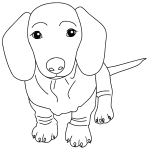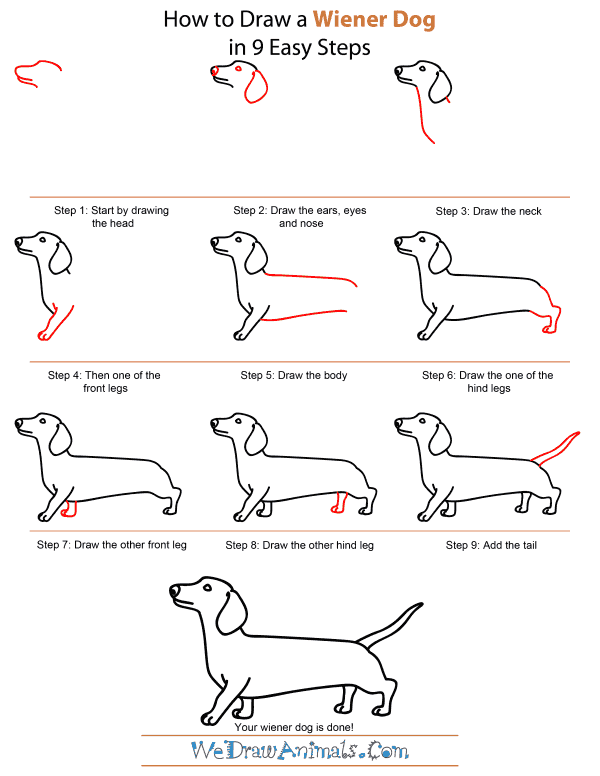In this quick tutorial you'll learn how to draw a Wiener Dog in 9 easy steps - great for kids and novice artists.
The images above represent how your finished drawing is going to look and the steps involved.
Below are the individual steps - you can click on each one for a High Resolution printable PDF version.
At the bottom you can read some interesting facts about the Wiener Dog.
Make sure you also check out any of the hundreds of drawing tutorials grouped by category.
How to Draw a Wiener Dog - Step-by-Step Tutorial
Step 1: A Wiener Dog, or Dachshund, is a small, short, and long dog that many people find cute. Start by drawing the top of the head, a curving line that turns into a slant, going up and to the left. The line should then dip to make the eyebrows, then go horizontal again to make the top of the snout. Make a rounded curve the loops back in to make the nose and the top lip. Add a small curved line below the top lip to make the chin.
Step 2: Now add a circle on the end of the snout to make the nose. Add an oval at the bottom of that circle to make the nostrils. Put in another small oval below and behind the eyebrow you drew before for the eye. Next, make a lopsided oval to make the big floppy Dachshund ear.
Step 3: Next we start drawing the neck and chest. Draw a line that goes mostly down, but slightly to the right from the bottom of the chin to make the chest. The end of this line should curve back slightly. Go ahead and add a small line on the bottom right side of the ear.
Step 4: For the front leg, we draw two lines that start far apart, and go down to come close together. The top line should have a small bump to imply a joint, and the bottom should be a rounded shape with two divots. At the divots, put in lines the make the individual toes.
Step 5: The back is draw with a very long, straight line that goes from the back of the neck you drew earlier. The very end should curve down very slightly at the end. The belly is a line that slopes up, from the back of the leg you've already drawn.
Step 6: For the first back leg, make a line that curves down from the rear, before bending out to make the back of the leg. Curve it back down to the foot. The other line starts at the back of the belly, and curves down before bending downward to the foot. There, it curves out, and meets the other line you've drawn. Now put a curved line on each foot to imply toes.
Step 7: Let's make the other front leg, with a small sock shape that is right behind the first front leg you've already drawn. Put a small line at the bottom of the sock shape to make the toes.
Step 8: Now for one last foot, with another similar sock shape just infront of the back leg you've drawn. Put a curved line at the bottom again to make the appearance of toes.
Step 9: Now for the tail! It should be two slightly wavy lines that go back from the rear, and meet in a neat point.
Interesting Facts about Wiener Dogs
Dachshunds are affectionately called wiener dogs, especially in the United States, because of their long hot-dog shaped bodies. Wiener dogs are also known for their stubby legs.
Did You Know?
- Wiener dogs are one of the top 10 dog breeds in the United States. They are the most popular breed in Europe.
- A full-grown standard wiener dog averages 16 to 32 pounds. Miniature wiener dogs typically weigh less than 12 pounds.
- Wiener dogs are generally three times longer than their tail.
- Some people train wiener dogs to compete in dachshund races, which are popular in several US states.
- On average, wiener dogs live to be 15 or 16 years old. Some have been known to live for 30 years.
- Wiener dogs are usually a shade of red, dark brown, or black-and-tan.
- Wiener dogs are very energetic and intelligent.
- Wiener have a keen sense of hearing and smell.
Wiener dogs are members of the hound dog family, a group of dogs used by hunters to track and chase animals. The term “dachshund” is German for the phrase “badger dog.” Wiener dogs used to be bred in Germany to track down badgers and other small animals that lived in burrows.

